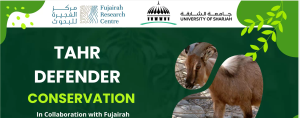
Tahr Defender: Revolutionizing Wildlife Protection with Drone and AI Technology
Introducing the Tahr Defender: Revolutionizing Wildlife Protection with Drone and AI Technology
As the world grapples with the ever-growing challenges of wildlife conservation, technological innovations are stepping up to offer groundbreaking solutions. One such pioneering system is the Tahr Defender, an advanced drone-based technology designed to protect and monitor the endangered Arabian tahr and other wildlife species. This system exemplifies how cutting-edge technology, including AI, deep learning, and mobile apps, can be harnessed to preserve biodiversity and ensure the survival of threatened species.
The Arabian Tahr: A Species at Risk
The Arabian tahr, native to the mountainous regions of the UAE and northern Oman, is a shy and elusive creature, often residing in rugged, inaccessible terrain. Classified as endangered by the International Union for Conservation of Nature (IUCN), the Arabian tahr faces threats from habitat destruction, poaching, and climate change. Traditional methods of monitoring and protecting these animals are challenging due to their habitat's difficult terrain and the species' reclusive nature.
Enter the Tahr Defender
The Tahr Defender system leverages the latest advancements in drone technology, AI, deep learning, and mobile applications to provide a comprehensive solution for wildlife conservation. This system is composed of a fleet of high-performance drones equipped with sophisticated sensors, cameras, AI-driven software, and user-friendly apps, all working in tandem to monitor and protect wildlife in real time.
Key Features of the Tahr Defender:
Autonomous Surveillance:
The Tahr Defender drones are designed for autonomous operation, enabling them to conduct surveillance missions without human intervention. These drones are equipped with GPS navigation and obstacle avoidance systems, allowing them to maneuver through the tahr's rugged habitat safely.
High-Resolution Imaging:
Each drone is fitted with high-resolution cameras and thermal imaging sensors, capable of capturing detailed images and videos both day and night. This capability is crucial for monitoring the Arabian tahr, which often remains hidden during the daytime.
AI-Powered Analytics and Deep Learning:
The data collected by the drones is processed using advanced AI algorithms and deep learning techniques that can identify individual animals, track their movements, and analyze their behavior. This real-time analysis provides invaluable insights into the tahr's habits, population dynamics, and health status. The deep learning models continuously improve, enhancing their accuracy and predictive capabilities over time.
Anti-Poaching Measures:
The Tahr Defender system also includes features to combat poaching. The drones can detect human presence in restricted areas and alert authorities immediately, enabling rapid response to potential threats. Additionally, the drones are equipped with loudspeakers and flashing lights to deter poachers.
Environmental Monitoring:
Beyond wildlife tracking, the Tahr Defender drones are capable of monitoring environmental conditions such as vegetation health, water sources, and signs of habitat degradation. This holistic approach ensures that conservation efforts are informed by comprehensive ecological data.
Mobile Applications for Rangers:
The Tahr Defender system is complemented by mobile apps designed to assist rangers in the field. These apps provide real-time data and alerts from the drones, enabling rangers to respond swiftly to threats and make informed decisions. The apps also facilitate easy communication and coordination among rangers, enhancing their efficiency and effectiveness.
Supporting Rangers in Harsh Conditions
Rangers play a crucial role in wildlife conservation, often working in harsh and challenging conditions. The Tahr Defender system significantly eases their workload and enhances their safety. With drones conducting autonomous surveillance, rangers can cover larger areas without physical strain. The AI-powered analytics reduce the need for manual data processing, allowing rangers to focus on critical tasks. The mobile apps provide rangers with instant access to vital information, improving their situational awareness and response times.
The integration of drones, AI, deep learning, and mobile technology means rangers are better equipped to perform their duties, even in remote and difficult-to-reach locations. This synergy of technology not only improves the effectiveness of conservation efforts but also ensures the safety and well-being of those on the front lines of wildlife protection.
Impact and Future Prospects
The deployment of the Tahr Defender system has already shown promising results in pilot programs across the UAE. These drones have enhanced the efficiency and accuracy of wildlife monitoring, significantly reducing the time and resources required for conservation efforts. Furthermore, the data collected is aiding researchers and policymakers in making informed decisions to safeguard the Arabian tahr and its habitat.
Looking ahead, the Tahr Defender system has the potential to be adapted for various wildlife conservation initiatives globally. By leveraging drone technology, AI, deep learning, and mobile apps, conservationists can better understand and protect endangered species, ultimately contributing to the preservation of global biodiversity.
Conclusion
The Tahr Defender represents a significant leap forward in the field of wildlife conservation. As we continue to face environmental challenges, the integration of innovative technologies like drone systems, AI, deep learning, and mobile applications will be crucial in our efforts to protect and preserve the planet's diverse species. The Arabian tahr, along with many other endangered animals, now has a fighting chance thanks to the Tahr Defender—an emblem of hope and resilience in the face of adversity.
This article highlights the transformative impact of the Tahr Defender system, showcasing its potential to revolutionize wildlife protection and conservation efforts. By leveraging the latest in drone technology, AI, deep learning, and mobile apps, the Tahr Defender is setting a new standard for how we safeguard our planet's precious biodiversity
